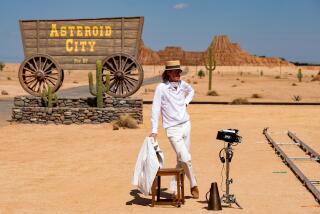In Fantasy and in Fact : ROALD DAHL: A Biography, <i> By Jeremy Treglown (Farrar, Straus & Giroux: $25; 322 pp.)</i>
- Share via
“Your threat to leave Knopf after this current contract is fulfilled leaves us far from intimidated,” Robert Gottlieb wrote Roald Dahl in 1980, after a long association that saw “James and the Giant Peach” and “Charlie and the Chocolate Factory” become two of the best-loved and best-selling children’s books in history. “You’ve managed to make the entire experience of publishing you unappealing for all of us. . . .” Gottlieb continued: “To be perfectly clear, let me reverse your threat: Unless you start acting civilly to us, there is no possibility of our agreeing to continue to publish you.”
Civilly was not an adverb of Dahl’s grammar-- boorishly, perhaps, and prodigally, piggishly, generously, childishly and enchantingly. As his editor, of course, Gottlieb knew it. How many editors today, out of sheer self-respect, would dismiss an author who ran up royalties of about $5 million a year?
Dahl stomped over to Farrar, Straus & Giroux for four successful books, huffed along to Viking for one more and died three years ago, leaving behind an uneasy reputation. He had written virulently about Israel and the Jews, had broken with his fellow literati--who never accepted him as one of their own--by denouncing Salman Rushdie instead of Salman Rushdie’s death sentence; and had distilled some odd, dark flavors in his writing that put off children’s book specialists, though not children.
Visiting Dahl’s grave in Great Missenden, England, Jeremy Treglown found it garlanded with plastic toys and a large onion. He has written the onion. His biography is as fumy, cantankerous and uneven as Dahl himself; sometimes mean, often funny and yet, after layers of peeling, offering us a fair-minded and even generous portrait. You wouldn’t want to know Dahl, perhaps, but you are glad to know of him.
Children’s classics tend to divide into the settling and the unsettling. The first may offer all kinds of distressful adventures along with their magic, but there is a framework that suggests that finally things are golden and OK: for example, “Winnie the Pooh,” “The Wind in the Willows,” the Oz books, “Black Beauty.” The second leave a quivering imbalance, not necessarily dark but perturbing: “Alice in Wonderland,” “The Princess and the Goblin,” Maurice Sendak’s books and Roald Dahl’s. Order does not prevail and cannot quite reassure; on the other hand, it does not suppress a child’s own disorder. Disorder is liberated instead--in Dahl, for example, with the dispatching of Charlie’s unpleasant aunts or, in “The BFG,” with the Big Friendly Giant’s proclivity for breaking wind at state occasions.
Treglown gives a concise but effective account both of the children’s books and of the clever, grisly short stories that Dahl wrote in the 1950s. Without straining, he portrays a Dahl who remarkably resembles his writing: a 6-foot-6 child of a man, with a need to bring off marvels and slay dragons. All too often both the marvels and the dragon-slaying were performed upon his friends and family, who lived in a steady din of feats and prowess.
As a bachelor in Washington, D.C., he painted the genitals of the rhinoceroses on the Q Street Bridge. After telling his children bedtime stories of a giant who prepared dreams and blew them through the windows, he put up a ladder outside the nursery, climbed it and rustled their curtains. When Olivia, his animal-loving daughter, died, Dahl went for consolation to Geoffrey Fisher, the retired Archbishop of Canterbury, only to leave in a fury when Fisher informed him that heaven had a no-dogs policy. The man’s life was agitated and agitating; one in which fantasy was all the more disruptive because to a considerable measure he made it come true.
Dahl was the son of a wealthy Norwegian ship broker who settled in England and died when he was young; he was raised by his mother and several doting sisters. He joined the Royal Air Force in World War II, and almost immediately crashed in the Egyptian desert after running out of fuel. He would embroider the embarrassment into a tale of heroic action; on the other hand, once recovered from severe injuries, he went on to become an authentic flying hero.
Assigned as an air attache in Washington, his real mission was to be a dashing example of British military prowess to capital circles whose Anglophilia Churchill counted as a main war resource. He hung out with the likes of Ian Fleming, C. S. Forester, Martha Gellhorn, Ernest Hemingway; and made love to a number of glamorous women including, by his account, Clare Boothe Luce. The Saturday Evening Post printed his embroidered first-person account of being “shot down”; Walt Disney planned for a while to make a movie from a Dahl scenario about gremlins. In an exchange of correspondence that prefigured his poker-faced fictional fantasies, Dahl warned Disney against depriving the gremlins of their bowler hats. They might, he wrote, make trouble.
Most important, he became the close friend and lifelong protege of Charles Marsh, a wealthy oilman with a taste for fantasy and game-playing equal to Dahl’s. Marsh’s money helped him keep going when he returned to England to write; his and his wife’s friendship helped steady Dahl’s stormy marriage to the actress Patricia Neal.
It was a remarkable marriage and it serves as the appropriate centerpiece of Treglown’s biography. It lasted 30 years, and divided with the drama of a Dahl tale into two sharply contrasting parts. For the first half Neal was the great figure: a Broadway and Hollywood star, beautiful and loved as well as courted by an array of glamorous friends. She had the money and the fame; Dahl, whose short stories had won him modest shares of each, had not yet begun the children’s books. The inequality made him all the more flamboyant and imperious; he dominated or overturned every dinner table. Neal, by Treglown’s absorbing account, loved and understood him enough to keep things going. He managed the money; she made his breakfast and lunch and bathed the babies--they had five--before going to work.
Twelve years later, in 1964, she had three disabling strokes, which put an end to the career, the glamour and her ability to care for her family. It seems to have been a spectacular if faintly queasy liberation for Dahl. With his first children’s books catching fire, he was the moneymaker. At home he became the immensely present father, and the fiercely authoritarian supervisor of Neal’s long convalescence. Like Mr. Willy Wonka of the chocolate factory, as Treglown points out, he could be the great magus and panjandrum, both in fantasy and fact.
Treglown, a former editor of the Times Literary Supplement, gives a full account of Dahl’s arrogance, intemperance and bullying qualities. His story of Dahl’s tantrums with his publishers, which grew worse as he grew more successful, virtually turn him into one of his own fairy-story monsters. Yet Dahl’s monsters had a comic charm; and so does Treglown’s Dahl.
More important, throughout this combative biography, something else shines through. As in his days in the RAF, Dahl was both a fantasy hero and a real one. He could be revoltingly unpleasant during the years his wife overshadowed him; yet, he had the great sanity to retreat with apparent weakness into his own strength, and give up adult fiction for the seemingly modest role of children’s writer. At home, his insistence on taking ferocious charge of everything including Neal’s rehabilitation may have been bullying. But it saved her life and gradually encouraged and tormented her into a recovery which, though not complete, allowed her to pursue a genuine if diminished career on the stage and in television.
Eventually--18 years after the strokes--Dahl left Neal for Felicity Crosland, with whom he had been having an affair for several years. But Treglown talked at great length with Neal, and more briefly with two of their daughters. (The second Mrs. Dahl and a third daughter, who is also writing a biography, did not cooperate.) And what he found was a mixture of gratitude, anger and awe at the memory of this human whirlwind, who blew debris along with dreams in through their windows, and blew them promptly out again through their door.
More to Read
Sign up for our Book Club newsletter
Get the latest news, events and more from the Los Angeles Times Book Club, and help us get L.A. reading and talking.
You may occasionally receive promotional content from the Los Angeles Times.








